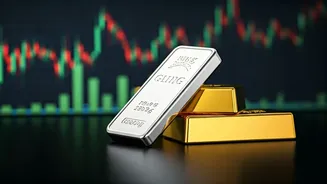Gold's Forecast: A Surge?
Financial analysts are making some bold predictions about gold. Some experts suggest that the price of gold could experience a remarkable surge in value.
This projection is based on a comprehensive evaluation of current market dynamics, encompassing elements such as global economic trends, geopolitical uncertainties, and investor behavior. The projected increase of up to 150% by 2028 reflects a strong belief in gold's enduring value and its potential to act as a secure haven during uncertain times. The analysis considers how central banks’ policies, inflation rates, and the strength of the U.S. dollar may all influence gold's future trajectory. It emphasizes that while gold has consistently demonstrated its resilience, its performance is subject to fluctuations. This forecast serves as a crucial point for investors, encouraging them to assess the strategic role of gold within their portfolios and contemplate the potential advantages of adjusting their investment strategies.
Driving Factors: Unpacked
Several pivotal factors are identified as potential catalysts for gold’s price surge. Economic uncertainties are often cited as a key driver. Geopolitical instability also plays a significant role; events like international conflicts or heightened tensions can lead investors to seek the safety of gold. Furthermore, inflation remains a crucial element. When the value of money decreases due to rising prices, gold can maintain or even increase its value. Central bank policies significantly influence gold prices; decisions regarding interest rates and quantitative easing impact market confidence. The strength of the U.S. dollar also matters. Gold prices and the dollar often move in opposite directions; a weaker dollar can make gold more attractive to international buyers. Understanding these interconnected elements is crucial for anticipating gold's price movements and making informed investment decisions. Each factor's interplay helps explain the dynamics of the gold market and can aid in understanding how the precious metal might perform in the years to come.
Investor Implications Explored
The prediction of a 150% surge in gold prices carries significant implications for investors worldwide. Firstly, there's the potential for substantial returns. If the forecast proves accurate, investors could see remarkable profits, making gold a highly attractive asset. Moreover, gold is known for its ability to hedge against inflation and economic instability, acting as a safeguard during uncertain periods. Gold's role as a diversifying element in investment portfolios is also highlighted. Including gold can help to decrease overall portfolio risk and improve long-term financial stability. It is also important to consider the timing of investment and the need for a diversified approach. Investors should evaluate how gold integrates into their broader financial strategies and consult with financial advisors to align their investment choices with their goals. Careful planning and a balanced approach are essential. Investors could consider various methods of investing in gold, from owning physical gold bars or coins to investing in gold ETFs or mining stocks.
Market Dynamics: A View
The gold market’s behavior is complex, influenced by various global forces. The supply and demand dynamic of gold is a significant factor. While the supply of gold increases through mining activities, demand is influenced by investment interests, jewelry purchases, and technological applications. Sentiment among investors greatly impacts gold prices. During times of economic turmoil or high inflation, investors tend to favor gold, driving up its value. In contrast, periods of economic stability may lead to reduced demand. Currency fluctuations play a crucial role, particularly the U.S. dollar. As gold is priced in dollars, a weak dollar can make gold more affordable for international buyers, raising demand. The actions of central banks and their policies have a direct impact on gold prices through interest rates. Low interest rates tend to make gold more attractive, while high rates can reduce its appeal. Understanding these multiple facets is vital for navigating the gold market and making smart financial decisions, as they create the complex landscape in which gold operates.







